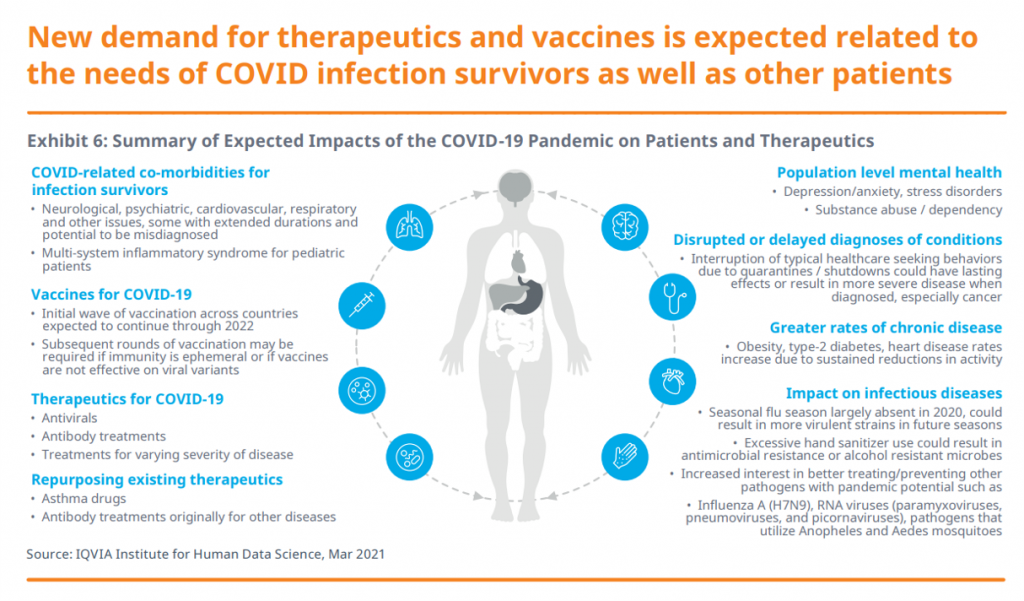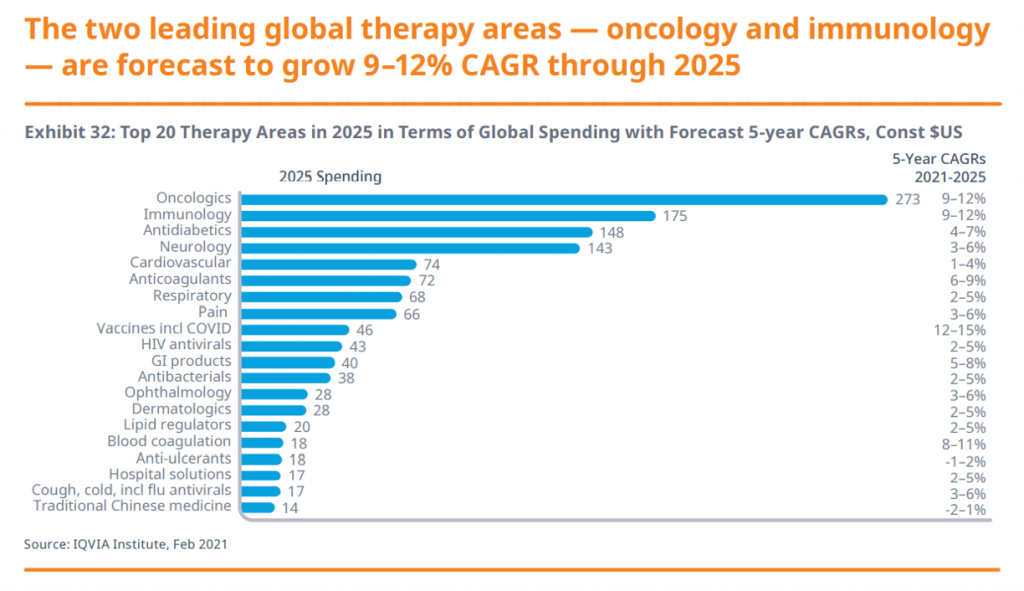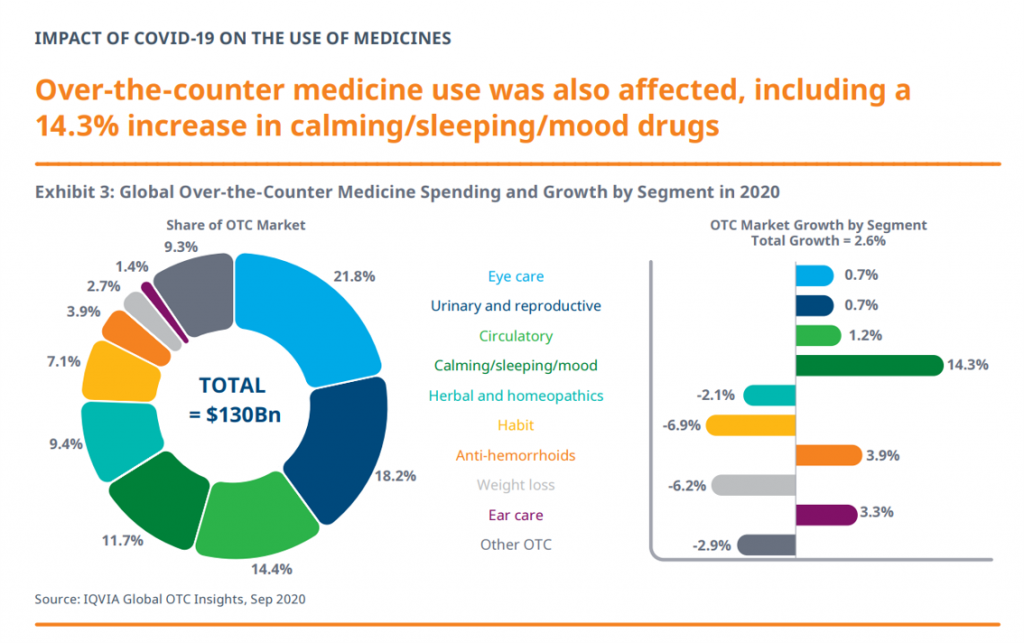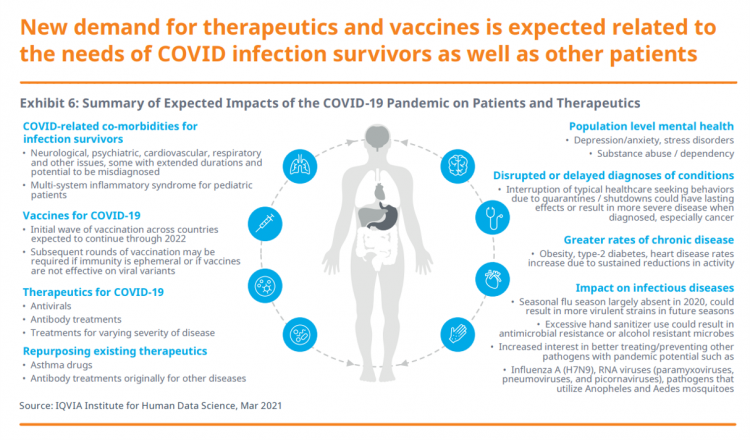Spending on medicines, globally, will rebound this year and rise above pre-pandemic levels through 2025. Between 2021 and 2025, the annual growth global growth rate for prescription drugs spending is expected to range from 3% to 6%, a $1.6 trillion bill for the worlds’s total Rx medicines market.
That relatively low single-digit growth rate is tempered by savings from biosimilars and the loss of brand exclusivity (that is, more generics coming to market). On the faster-growth side, we can expect two big therapeutic areas to drive spending upward: oncology and immunology, projected to expand by 9% to 12% each year to 2025, according to IQVIA Institute for Human Data Science in their report, Global Medicine Spending and Usage Trends: Outlook to 2025.
 As usual, there are many lenses to wear when reviewing this annual report; in this Health Populi blog post, I’m donning my usual health consumer take, but do explore the forecast for yourselves through your own filters as IQVIA Institute always provides the full landscape for drugs spending that’s relevant to payors, plans, providers, and of course, patients.
As usual, there are many lenses to wear when reviewing this annual report; in this Health Populi blog post, I’m donning my usual health consumer take, but do explore the forecast for yourselves through your own filters as IQVIA Institute always provides the full landscape for drugs spending that’s relevant to payors, plans, providers, and of course, patients.
This first chart from the report summaries one of the top-line themes: how COVID-19 is re-shaping patients and therapeutics. Key takeaways here are that:
- Patients who survived the coronavirus infection can have or develop co-morbidities lasting as long-COVID or conditions that require treatment for cardiovascular, neurological, psychiatric, respiratory and other issues
- Antivirals, antibody treatments, and other treatments targeting different levels of severity will be in demand
- Existing therapies for asthma and antibody tx for other diseases will be repurposed for COVID-19 therapeutics
- Population-level mental health addressing depression/anxiety, stress, and substance use/dependency will be in demand
- Greater rates of chronic disease can be expected due to the pandemic era of postponing care or avoiding self-care and prevention, in particular obesity, type-2 diabetes, and heart disease, among other impacts.
 In the ten developed countries in the IQVIA Institute forecast, oncology has the greatest burden of disease, spending for which increased at a rate of 14% annually looking back to 2010 to 2019.
In the ten developed countries in the IQVIA Institute forecast, oncology has the greatest burden of disease, spending for which increased at a rate of 14% annually looking back to 2010 to 2019.
Going forward 2021 to 2025, shown here, we can expect oncology to grow by between 9% and 12% globally. That same growth rate is expected for the second largest area of Rx spending, immunology. The next three largest therapy areas for spending are antidiabetics, neurology, and cardiovascular, each growing at a rate of 7% of less between 2021 and 2025.
Note that the largest increases in global spending for a therapy is projected to be for vaccines and COVID, ranging from 12% to 15% from 2021-25.
Specialty medicines are expected to comprise about 60% of Rx spending in developed markets in 2025, tempered by spending on generics and biosimilars.
 Health Populi’s Hot Points: Tracking health consumer behavior from the emergence of the pandemic in 2020, the “Year of COVID,” to the current scenario of 2021, the “Year of Vaccines,” patients in the pandemic era took on greater self-care agency with certain over-the-counter medicines categories growing for care during the stay-at-home journey.
Health Populi’s Hot Points: Tracking health consumer behavior from the emergence of the pandemic in 2020, the “Year of COVID,” to the current scenario of 2021, the “Year of Vaccines,” patients in the pandemic era took on greater self-care agency with certain over-the-counter medicines categories growing for care during the stay-at-home journey.
The circle-pie chart from IQVIA Institute’s report details different categories’ share of OTC spending, with the largest dollars spent by consumers on eye care, urinary and reproductive, circulatory, calming/sleep/mood, and herbal and homeopathic remedies.
The chart to the right of the pie tells a huge story in one green horizonal bar: that is the 14.3% growth in consumers’ spending on solutions for calming, sleeping, and mood.
The pandemic wreaked havoc on our mental and behavioral health. Some people felt/feel isolated in the long COVID era of working/schooling from home. Others of us feel anxiety and stress due to negative financial impacts from the shutdown economy, recovering in a K-shape where some citizens have fared pretty well (largely, those who could work-from-home and those who had investments in the stock market), and others on the low-tail of that K whose household finances eroded in 2020.
The mental/behavioral health epidemic has been a toxic side-effect from the COVID-19 pandemic that will persist long after the virus fades and human lives appear to get back to their next-normal. What will be normal within that normal is that millions of people will still feel anxious, stressed, and worried about post-Corona life in peoples’ heads, hearts, and wallets.
As such, the debate on prescription drug pricing in the U.S. is heating up, with President Biden mentioning the scenario of Medicare negotiating drug prices with pharmaceutical manufacturers in his latest speech measuring progress at 100 days in the White House. Drug prices continue to be front-of-mind for patients with chronic conditions and cancer diagnoses, and should continue to be a top 10 issue for voters approaching 2022 mid-term elections.





 Thanks to Feedspot for naming this blog, Health Populi, as a
Thanks to Feedspot for naming this blog, Health Populi, as a